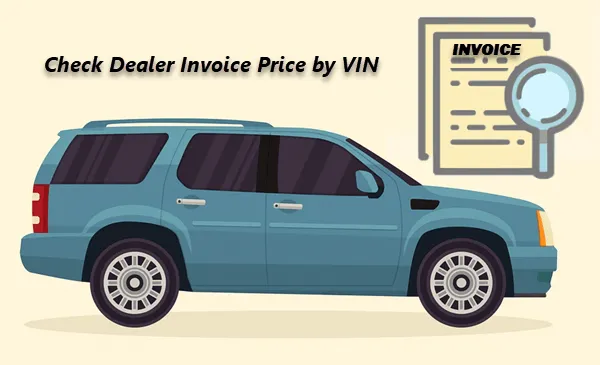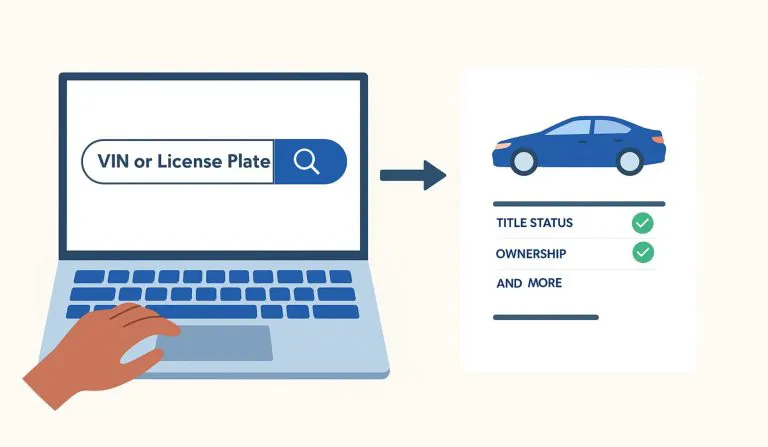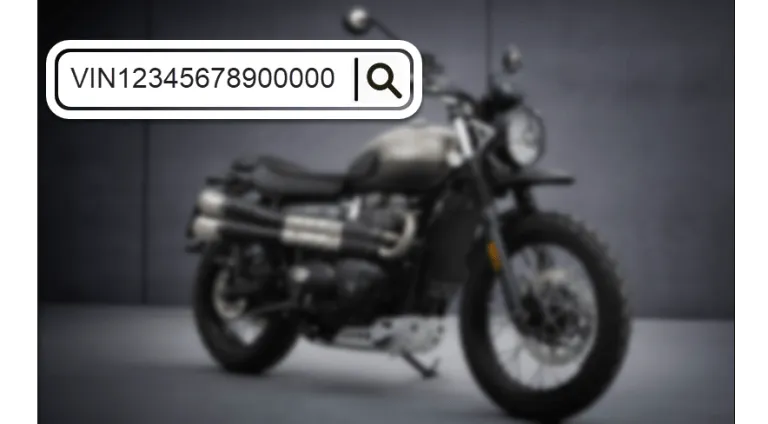How To Decode A VIN – What Every Digit Means
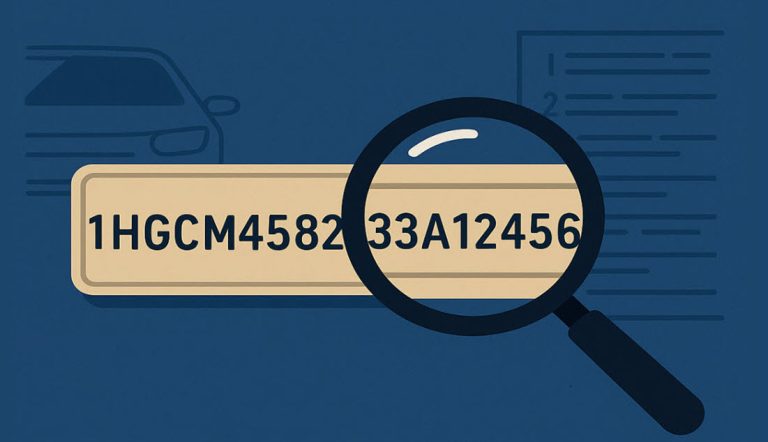
Ever noticed the long string of letters and numbers on a car’s door jamb or title? That’s the VIN, short for Vehicle Identification Number. While it might look random, every digit in this code tells a story: where the car was built, what kind of engine it has, and even which plant assembled it.
Whether you’re checking out a used car and just curious about what those digits mean, decoding a VIN can reveal more than you’d expect. In this article, we’ll break down what each digit of VIN represents and how to decode it to obtain helpful information.
What is a VIN?
The Vehicle Identification Number (VIN), or known as chassis number or frame number, is a unique code assigned to a vehicle during manufacturing. It’s typically 17 characters long, combining numbers and letters, except I, O, and Q to avoid confusion with 0, 1, and 9. Much like a person’s SSN (Social Security Number), the VIN stays with a vehicle for life and is tied to a vast amount of vehicle details and history. You’ll need a VIN in many situations, from buying and selling a car to registering, insuring, or tracking its history.
Fun fact: Do you know how VINs came to be?
In fact, VIN wasn’t always the 17-character code we know today. It first appeared in the U.S. in 1954, but back then, each manufacturer had their own formats, and VINs were just simple serial numbers. Things started to get organized in the late 1970s, when the International Organization for Standardization (ISO) introduced global VIN guidelines (ISO 3779 and 3780)1, now used in Europe and many other parts of the world.
Shortly after, the U.S. National Highway Traffic Safety Administration (NHTSA)2 created a stricter 17-character VIN format, which is mandatory for all on-road vehicles in the U.S. and Canada starting with the 1981 model year. These two standards work similarly, but might differ slightly in how certain digits are interpreted.
Where to find the VIN?
On most passenger vehicles and trucks like pickups, the VIN is visible through the windshield on the driver’s dashboard, on a sticker on the driver-side doorjamb, or sometimes stamped on the front of the engine block. Official documents like a title, registration card, or insurance ID card should have the VIN listed as well.

Other types of vehicles may have their VINs located in different places. On motorcycles, VIN is usually on the right side of the headstock tube, while on an RV, the VIN may be printed on a sticker near the main entry door.
Read more: Where to Find VIN (With or Without the Car)
How to decode a VIN?
Decoding a VIN usually means breaking down what each digit in the 17-character code tells you, from the car’s make, model, to where it was built and even what type of engine it has. You can use a VIN decoder to get a quick overview, or take a deep dive yourself if you’re curious about how the pattern works.
If you’re researching a car, especially a used one, you’ll want more than just specs. You probably want to know how the car has been treated over the years, whether it has been in an accident, how many previous owners it has had, whether it has been properly maintained, and so on. That’s where a VIN lookup comes in. By collecting massive data from a variety of exclusive sources, it can offer you offer valuable insights into a vehicle’s history.
| Feature | VIN decoder | VIN lookup |
| Information provided | Make, model, year, engine type, body style, manufacturing country, and plant, etc | Accident records, repair & service records, ownership history, title and registration history, odometer readings, recalls, and more |
| Data source | Manufacturer’s decoding guidelines | State DMVs, police agencies, insurance companies, auction sites, auto repair shops, and so on |
| Is it free? | Typically Yes | Often paid, though some services offer limited free reports |
Below, we’ll walk through both so you know better what you can find and how to do it.
Interpret each VIN digit to understand a vehicle’s build and specs
Every VIN is unique and structured to reveal specific details. If you just want a quick rundown of a vehicle’s specs, Super Easy VIN decoder (free) is the best bet. It can extract a wealth of information encoded in the VIN, including the model year, country of origin, manufacturing plant, vehicle type, engine-related information, and much more.
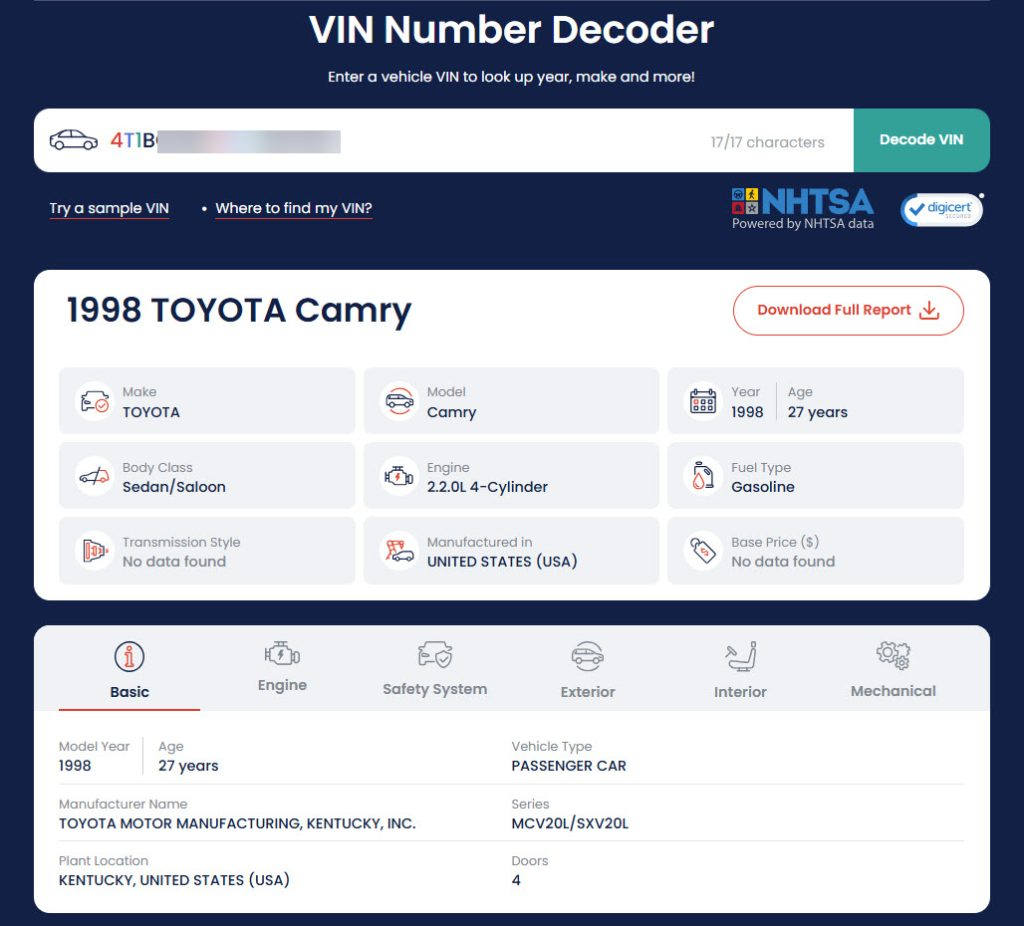
Alternatively, you can look for manufacturer-specific VIN decoders, which often offer more details than general third-party tools. For example, a Honda VIN decoder might reveal not only the basic specs, but also vehicle features, equipment, interior and exterior colors, and even the original MSRP (Manufacturer’s Suggested Retail Price)3.
Prefer to understand the digits yourself? You absolutely can – but fair warning: it’s really time-consuming, and you’ll uncover the same basics as a free decoder. But if you love to explore the process, here’s the breakdown.
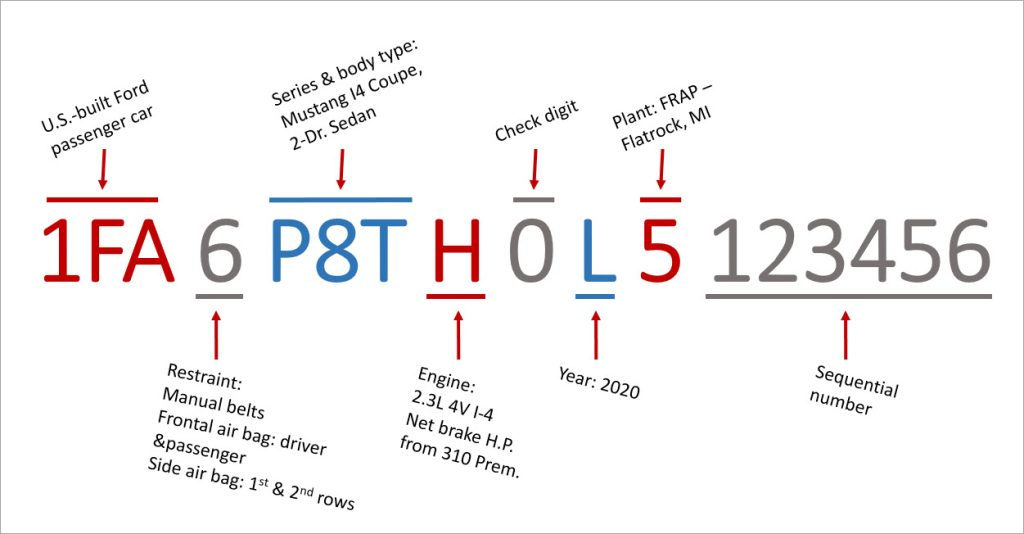
Digits 1 – 3: World Manufacturer Identifier (WMI)
The first three characters of a VIN are known as the World Manufacturer Identifier, which tells you where the vehicle was built and who made it. The first digit typically identifies the region of the manufacturer. For example:
- 1, 4, 5, & 7 = United States
- 2 = Canada
- 3A – 3X = Mexico
- W = Germany
- J = Japan
- KL – KR & K1 – K3 = South Korea
The second digit points to the manufacturer. For example, F is Ford, G is General Motors, T for Toyota, and H for Honda. The third digit often pinpoints the specific vehicle type, like passenger car, truck, or motorcycle, or completes the manufacturer’s unique code.
Because of the proliferation of makes for passenger vehicles, large manufacturers with multiple makes of vehicles will obtain multiple WMIs. Here are some of Toyota’s WMIs based on different vehicle types and manufacturing locations.
JTE – Japan-built Toyota car (Japan)
JTD – Japan-built Toyota MPV/SUV
JTM – Japan-built Toyota SUV
2T1 – Canada-built Toyota car
4T1 – U.S. (Kentucky) Toyota car
4T3 – U.S. (Kentucky) Toyota MPV/SUV
5TD – U.S. (Indiana) Toyota MPV/SUV
5TF – U.S. (Texas) Toyota truck
…
You can find a list of common WMI here for reference.
Digits 4 – 8: Vehicle Descriptor Section (VDS)
These five digits usually identify the vehicle type, the model, the engine type, and body style. Each manufacturer has its own system for using this field, so it can vary quite a bit. You can search for the “manufacturer’s name + VIN code” online to see if there’s an official guideline for decoding.
NHTSA also provides a centralized source where manufacturers report their VIN formats, as required by the Federal Motor Vehicle Safety Standard (FMVSS)4 Part 565. Simply start a search by the manufacturer’s name, e.g., Ford.
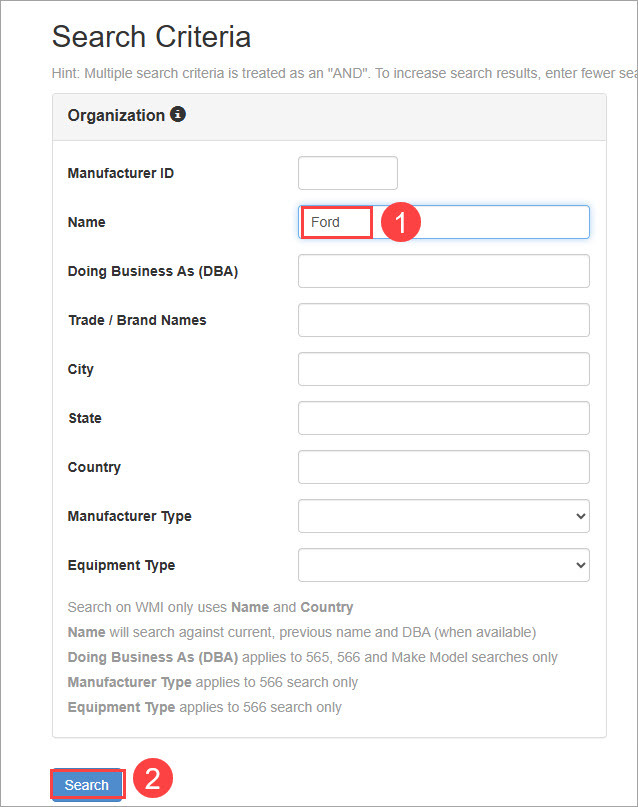
Then, refine the results by the manufacturer’s location and model year (see How to check model year from VIN). The decoding rule can change between different model years. Open the available files to see what each digit represents.
Honestly, deciphering this section is like trying to crack a secret code – it’s more challenging than expected. For example, Ford might use the 4th digit to indicate the restraint system category, digit 5 – 7 for make, car line, series, and body type, and digit 8 for engine-related information, while Chevrolet uses digit 4 and 5 to define the vehicle series, 6 for body style, 7 as a restraint code, and 8 for engine type.
Sometimes, it’s not a simple one-to-one mapping. Instead, multiple digits work together to indicate a unique trim or model version. Honda, for example, uses digits 4 – 8 of the VIN as a model mode, which reflects its model, trim, drive system, transmission, body type, gross vehicle weight range, restraint system, and engine model.
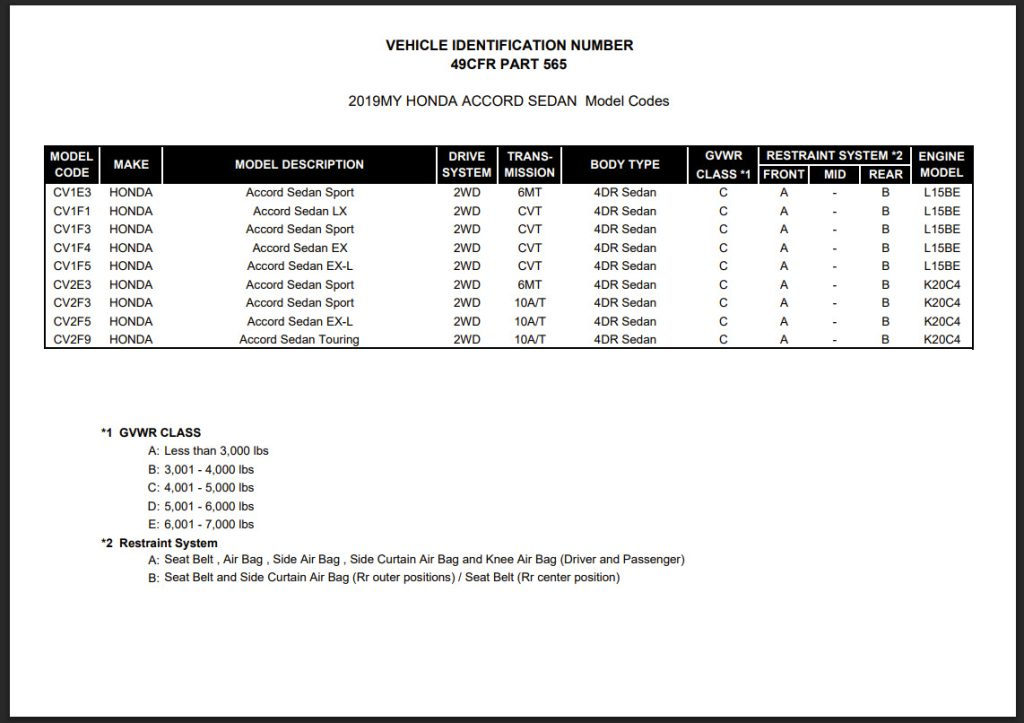
Through the engine model, you can further learn about the engine characteristics.
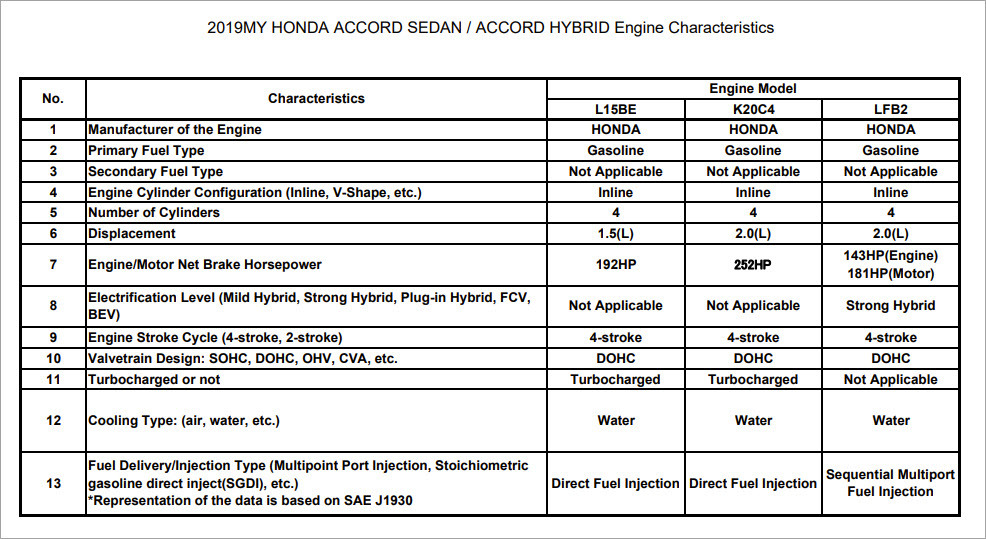
Digit 9: Check digit
For a North American VIN, the 9th position is for verifying if it’s valid. While it doesn’t tell you anything about the car itself, it works as a built-in security check to detect typos or fake VINs.
You can use the NHTSA check digit calculator to confirm if it’s correct.

Curious about the calculation behind it? Here’s how it works:
Step 1: Convert letters into their corresponding numerical alternatives. Numbers keep their values.
| A=1 | B=2 | C=3 | D=4 | E=5 | F=6 | G=7 | H=8 | / |
| J=1 | K=2 | L=3 | M=4 | N=5 | / | P=7 | / | R=9 |
| / | S=2 | T=3 | U=4 | V=5 | W=6 | X=7 | Y=8 | Z=9 |
Step 2: Assign each digit position a specific weight. The weight for the 9th position (check digit) is zero.
| 1 | 2 | 3 | 4 | 5 | 6 | 7 | 8 | 9 | 10 | 11 | 12 | 13 | 14 | 15 | 16 | 17 |
| 8 | 7 | 6 | 5 | 4 | 3 | 2 | 10 | 0 | 9 | 8 | 7 | 6 | 5 | 4 | 3 | 2 |
Step 3: Multiply the value of each character by its assigned weight.
| VIN | 5 | G | Z | C | Z | 4 | 3 | D | 1 | 3 | S | 8 | 1 | 2 | 7 | 1 | 5 |
| Value | 5 | 7 | 9 | 3 | 9 | 4 | 3 | 4 | 1 | 3 | 2 | 8 | 1 | 2 | 7 | 1 | 5 |
| Weight | 8 | 7 | 6 | 5 | 4 | 3 | 2 | 10 | 0 | 9 | 8 | 7 | 6 | 5 | 4 | 3 | 2 |
| Result | 40 | 49 | 54 | 15 | 36 | 12 | 6 | 40 | 0 | 27 | 15 | 56 | 6 | 10 | 28 | 3 | 10 |
Step 4: Add up the results and then divide by 11.
If the remainder matches the check digit (the 9th digit), the VIN is likely valid. If the remainder is 10, the check digit should be X. For example, for the VIN above, the total of the results is 408, and the remainder after dividing 408 by 11 is 1, which matches the check digit.
Digit 10: Model year
This digit reveals the vehicle’s model year. Besides the three letters mentioned before that are not allowed in the VIN itself (I, O, and Q), the letters U and Z, and the digit 0 are not used for the model year code either.
| Code | Year | Code | Year | Code | Year |
|---|---|---|---|---|---|
| A | 1980 | L | 1990 | Y | 2000 |
| B | 1981 | M | 1991 | 1 | 2001 |
| C | 1982 | N | 1992 | 2 | 2002 |
| D | 1983 | P | 1993 | 3 | 2003 |
| E | 1984 | R | 1994 | 4 | 2004 |
| F | 1985 | S | 1995 | 5 | 2005 |
| G | 1986 | T | 1996 | 6 | 2006 |
| H | 1987 | V | 1997 | 7 | 2007 |
| J | 1988 | W | 1998 | 8 | 2008 |
| K | 1989 | X | 1999 | 9 | 2009 |
| Code | Year | Code | Year | Code | Year |
|---|---|---|---|---|---|
| A | 2010 | L | 2020 | Y | 2030 |
| B | 2011 | M | 2021 | 1 | 2031 |
| C | 2012 | N | 2022 | 2 | 2032 |
| D | 2013 | P | 2023 | 3 | 2033 |
| E | 2014 | R | 2024 | 4 | 2034 |
| F | 2015 | S | 2025 | 5 | 2035 |
| G | 2016 | T | 2026 | 6 | 2036 |
| H | 2017 | V | 2027 | 7 | 2037 |
| J | 2018 | W | 2028 | 8 | 2038 |
| K | 2019 | X | 2029 | 9 | 2039 |
From the list, you may notice that characters have been repeated since the 2010 model year. For example, “S” can represent both 1995 and 2025. Therefore, to figure out the exact year of a passenger car, you’ll need to look at both the 7th and 10th digits of the VIN. If the 7th digit is a number, the 10th position refers to a model year between 1980 and 2009. However, if it’s a letter, the model year falls between 2010 and 2039.
Digit 11: Assembly plant
This position is for identifying the assembly plant at which the vehicle was built. Just like the vehicle descriptor section code, each manufacturer has its own set of plant codes, which you can find in their manufacturer guides.
Digit 12 – 17: Sequential number
The final section contains numeric characters used by the manufacturer to identify a particular vehicle. While digits 4 – 8 (vehicle descriptor section) describe the general attributes, digits 12 – 17 ensure no two vehicles are exactly alike. They aren’t connected to features but represent the sequential number of a vehicle in the production process. Each manufacturer has its own numbering system.
Why won’t a VIN decode?
If a VIN doesn’t decode properly, either with a tool or manually, here are some common reasons to troubleshoot.
- The VIN isn’t 17 digits long.
Modern VINs (1981 and newer models) are required to have a 17-character VIN. If your VIN is shorter, ranging from 5 – 13 digits, it could be from a pre-1981 classic vehicle that used non-standard VIN formats. Most online tools can’t decode these, and you’ll need other methods and resources.
- The VIN is invalid.
Check for typos or misread characters. VINs never include the letters I, O, or Q, and the last six characters should typically be numbers. Also, the 9th digit is a check digit calculated from the rest of the VIN. If this digit doesn’t match the expected value, the VIN may be invalid, or possibly even tampered with.
How to decode a classic VIN
Like modern VINs, classic VINs can also be decoded, either manually or by using a specialized tool. But since pre-1981 VINs don’t follow a standardized format, the process is often trickier.
Still, the easiest option is to use a VIN decoder, but ones like DecodeThis that work for classic VINs. Simply enter the number, and it can instantly pull a car’s key specifications like model year, make, series, trim level, body style, dimensions, transmission, and engine-related info, which are often more detailed than you’d get from decoding manually.
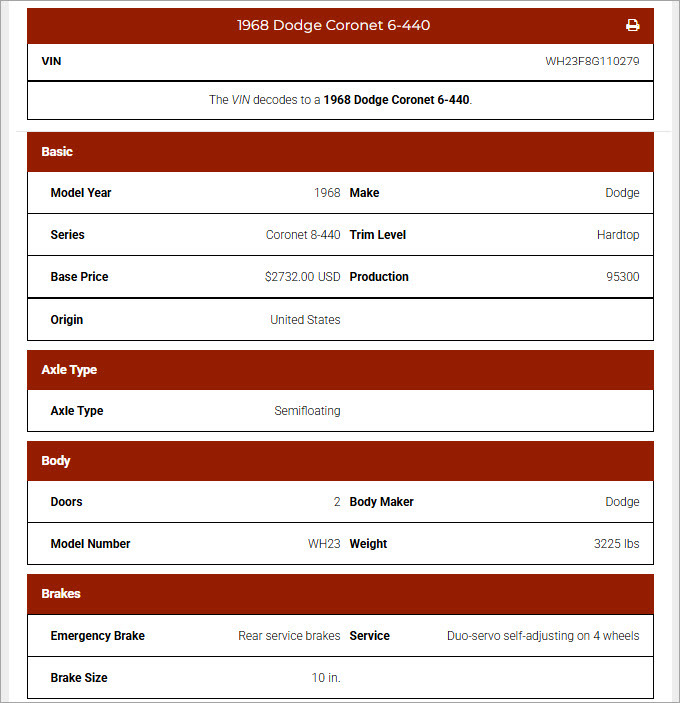
If you want to decode it yourself, it can be a fun process. There are lots of resources online to help. Plug the VIN into Google. In some cases, relevant info or decoding results show up right in the search results.
Getting no results? Try broadening your search with terms like “make + year + VIN” to find decoding guides or charts. An effective tip is to search “make + year + VIN + filetype:pdf”. This narrows the results to PDF documents, which are more likely to contain official guidelines or scanned manuals.
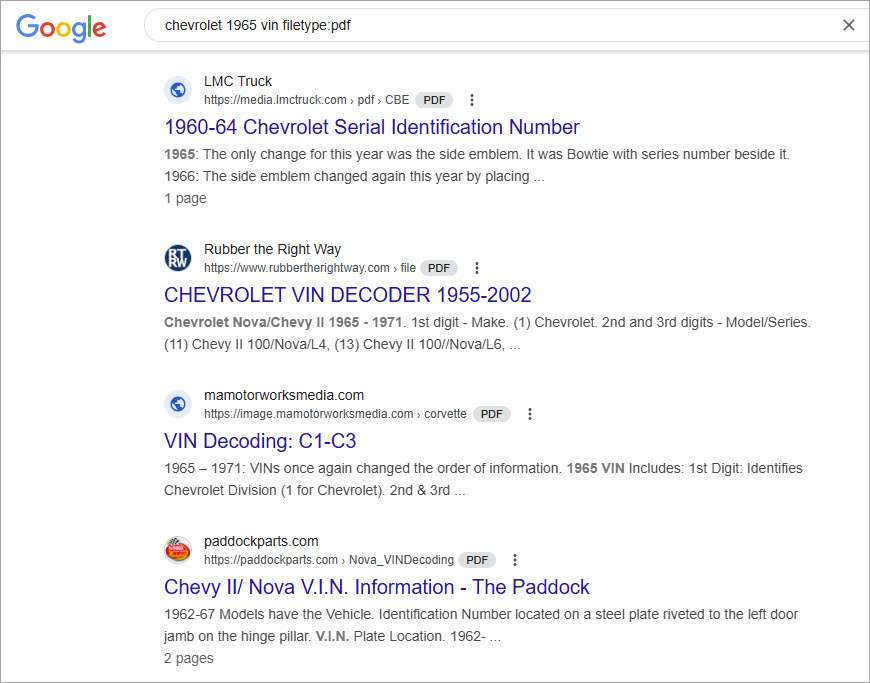
Classic VINs vary in length, typically from 5 to 13 characters, and their structures differ depending on the manufacturer, model, and year. For example, here’s how a Chevrolet VIN from 1965 – 1971 is structured:
- 1st digit: Make (1 = Chevrolet)
- 2nd digit: Series or model (e.g., 2 = Camaro, 3 = Chevelle, 9 = Corvette…)
- 3rd digit: Engine (1 = 4 or 6 cylinder, 3/5/7 = 6 cylinder, 2/4/6/8 = V8)
- 4th and 5th digits: Body style
- 6th digit: Year (5=1965, 6=1966, 7 = 1967,8 = 1968, 9 = 1969, 0 = 1970, 1 = 1971)
- 7th digit: Assembly plant
- 8th to 13th digits: Sequential number
What details can you decode from a VIN?
A VIN decoding can tell you a lot about the vehicle details, but it doesn’t cover everything. Some details can’t be determined by the VIN alone, such as:
- Trim level and transmission. These specs are sometimes embedded in the VINs, but not consistently. Some manufacturers include them directly, while others only imply them, such as when only one trim or transmission option is paired with a certain engine or model.
- Curb weight and Gross vehicle weight rating (GVWR). Curb weight is the total mass of a vehicle with standard equipment and all necessary operating consumables. Gross vehicle weight rating is larger, including the maximum payload of passengers and cargo. These exact values cannot be directly determined by VIN, as they can vary depending on the optional equipment installed. By decoding a VIN, you can often only know the gross vehicle weight class.
- Exterior/interior color and upholstery. VINs generally don’t include styling details like paint codes or interior themes, unless there’s only one factory option for that particular trim.
- Optional equipment. You won’t know if a car has features like a sunroof, navigation system, or upgraded sound package just from decoding the VIN, since these are often added through options or upgrades after the base model is assigned its VIN.
To get a fuller picture of a vehicle’s specifications as well as its history, you’ll need a dedicated VIN lookup or vehicle history report.
Use a VIN lookup tool to unlock a vehicle’s full history
While VIN decoding tells you how a vehicle was originally built, a VIN lookup goes further by revealing what’s happened to it over time. Like using a VIN decoder, it’s easy to get started. Just choose a reliable tool, enter the VIN, and you’ll receive the results.
We recommend reputable VIN lookup services like Carfax, Autocheck, Bumper, and Vinaudit. As approved NMVTIS (National Motor Vehicle Title Information System)6 data providers, they can access the NMVTIS system, which collects data from state motor vehicle titling agencies, insurance carriers, auto recyclers, junk yards, and salvage yards, to offer important vehicle condition and history. Besides, they obtain valuable insights from various government agencies and exclusive industry partners, offering a more complete view of a vehicle’s background.
Depending on the provider and available records, you may be able to see:
- A full list of standard equipment
- Accident and damage records
- Title and registration records
- Ownership and mileage history
- Sales listings
- Maintenance and service records
But don’t stop at just reading what’s listed. By connecting the dots between different data points, you can often uncover deeper insights. For example, an ownership change shortly after an accident might hint at more serious damage than what’s officially reported. Repeated repairs on a specific part could signal a persistent issue. To spot these subtle clues, check out our full guide on How to read a VIN lookup report.
Decoding a VIN can provide valuable insights into a vehicle’s origins and build. While simple decoders offer quick specs, a VIN lookup tool is essential if you’re looking for vital information beneath the surface, like accident records, ownership history, and more. Understanding both VIN decoding and lookup methods will empower you to make informed decisions when buying, selling, or researching any vehicle.
- ISO 3779 is the main standard that defines the structure and content of the VIN, while ISO 3780 defines only the WMI, the first three characters of the VIN.[↩]
- National Highway Traffic Safety Administration (NHTSA) is an agency of the U.S. federal government, part of the Department of Transportation, focused on automobile safety regulations.[↩]
- It’s the price that a manufacturer recommends a retailer to sell the product.[↩]
- Federal Motor Vehicle Safety Standards are U.S. federal vehicle regulations that specify relevant requirements for motor vehicles.[↩]
- According to ISO 3779, if the manufacturer chooses to designate year or plant in the Vehicle indicator section, it’s recommended that the year be indicated by the first character and the plant by the second character of the section.
[↩] - The National Motor Vehicle Title Information System (NMVTIS) is designed to prevent automobile theft and fraud and provide an electronic means for verifying and exchanging title, brand, theft, and other vehicle data.[↩]

 View all of Brinksley Hong's posts.
View all of Brinksley Hong's posts.

